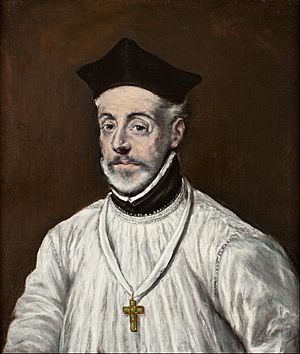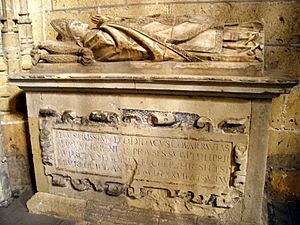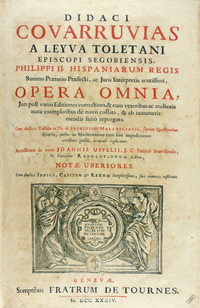Diego de Covarubias y Leyva facts for kids
Quick facts for kids Most Reverend Francisco Andrés de Carvajal |
|
|---|---|
| Archbishop (Personal Title) of Cuenca | |

Diego de Covarrubias, by El Greco
|
|
| Church | Catholic Church |
| Diocese | Diocese of Cuenca |
| Predecessor | Gaspar de Quiroga y Vela |
| Successor | Rodrigo de Castro Osorio |
| Orders | |
| Consecration | April 28, 1560 by Fernando de Valdés y Salas |
| Personal details | |
| Born | July 25, 1512 Toledo, Spain |
| Died | September 27, 1577 (age 65) Madrid |
| Nationality | Spanish |
| Previous post | Archbishop of Santo Domingo (1556-1560) Archbishop (Personal Title) of Ciudad Rodrigo (1560-1564) Archbishop (Personal Title) of Segovia (1564-1577) |
Diego de Covarrubias y Leyva (born July 25, 1512 – died September 27, 1577) was an important Spanish expert in law and a leader in the Catholic Church. He held several high positions during his life. He was a bishop in different cities in Spain, including Segovia and Ciudad Rodrigo. He was also named Archbishop of Santo Domingo, which is in the New World (now the Dominican Republic). Diego de Covarrubias was known for his brilliant mind and his work in both law and church matters.
Contents
Life of Diego de Covarrubias
Early Life and Education
Diego de Covarrubias was born in Toledo, Spain, on July 25, 1512. His father, Alonso de Covarrubias, was a famous architect. He designed parts of the Cathedral of Toledo. Diego's younger brother, Antonio de Covarrubias, became a law professor. He taught at the University of Salamanca.
Diego also studied at the University of Salamanca. He focused on canon law, which is church law. He also studied theology, which is the study of religious faith. His teachers were very famous scholars of their time.
When he was only 21, Diego became a professor of canon law. He was later asked to help reform the University of Salamanca. The new rules he created for the university lasted for a long time. People admired his knowledge of law so much. They called him the "Bartolus of Spain." Bartolus was a very famous Italian lawyer.
Diego's legal knowledge was vast. He wrote clearly and beautifully. His mind was very broad. He studied many subjects that helped him understand law better. It is said that he wrote notes in every book in the large library of Oviedo. He became a professor there at age 26.
Becoming a Bishop
In 1556, Charles V, Holy Roman Emperor, chose Diego to be the Archbishop of San Domingo. This city was in the New World. However, Diego never actually went there.
In 1560, he was appointed Bishop of Ciudad Rodrigo in Spain. On April 28, 1560, he officially became a bishop. He was consecrated by Fernando de Valdés y Salas, the Archbishop of Sevilla.
Work at the Council of Trent
As a bishop, Diego attended the Council of Trent. This was a very important meeting of the Catholic Church. It aimed to reform the Church. His nephew said that Diego worked with another important church leader, Cardinal Ugo Buoncompagni. They were supposed to write the reform rules for the council.
Cardinal Buoncompagni was busy with other tasks. So, Diego de Covarrubias did most of the work alone. The rules for reform were formally approved by the council. This means we likely owe the text of these important rules to him.
Later Life and Death
After returning to Spain, Diego was moved to the See of Segovia in 1565. Until then, his amazing talents were mostly used in academic work. But now, he started to work in practical government affairs.
In 1572, he became a member of the Council of Castile. This was an important government body. Two years later, he became the president of the Council of State. He was very successful in this role.
While he was president, Philip II of Spain nominated him to be the Bishop of Cuenca. But Diego de Covarrubias died before he could take on this new role. He passed away in Madrid on September 27, 1577. He was 65 years old.
Diego de Covarrubias was buried in a marble tomb. His tomb is in Segovia Cathedral. It is near an old entrance that now leads to the cloister.
His Writings
Diego de Covarrubias wrote many important books. His main work is called Variarum resolutionum ex jure pontificio regio et cæsareo libri IV. This book is about different legal decisions.
He also wrote about many other topics. These included wills, engagements and marriage, oaths, and excommunication. He also wrote about how long a right lasts and how to give things back.
One of his unique works was about coins. It was called Veterum numismatum collatio cum his quæ modo expenduntur. This book compared old coins with those used in his time. His complete works have been published several times. The Antwerp edition from 1762 is considered the best.
Among his notes, there were writings about the Council of Trent. He also had a paper on punishments. And he wrote a historical list of the kings of Spain.
See also
 In Spanish: Diego de Covarrubias para niños
In Spanish: Diego de Covarrubias para niños



